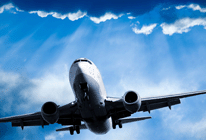EU Top Court Upholds Aviation's Entry into ETS
 Airlines arriving into and departing from European Union airports from January 1, 2012, will be subject to the EU’s Emissions Trading Scheme, following a ruling by the European Court of Justice.
Airlines arriving into and departing from European Union airports from January 1, 2012, will be subject to the EU’s Emissions Trading Scheme, following a ruling by the European Court of Justice.The judgement by Europe’s highest court follows a case brought by US carriers United and American Airlines in 2009, which opposed the inclusion of foreign carriers within the ETS scheme.
The European Court of Justice in Luxembourg dismissed arguments that imposing the European Union’s cap-and-trade program on flights to and from European airports infringes on national sovereignty or violates international aviation treaties.
The ruling means that from the start of next year all carriers operating into and out of EU airports will have to purchase allowances to cover their carbon emissions.
The EU agreed in 2008 to include airlines in its six-year-old ETS that currently covers more than 10,000 industrial and power plants in Europe. The new rules, which will apply to any airline landing in the EU - including foreign carriers, was hotly contested by the airline industry.
The dismissed lawsuit was brought by U.S. and Canadian airlines acting through the industry trade organization Airlines for America, but the protest was supported by China, India and other countries with international carriers.
The National Airlines Council of Canada says it will contest the decision. Canadian airlines will be working with the federal government and about 43 other countries, including the United States - that disagree with the EU’s position.
The council represents Air Canada, WestJet Airlines, Jazz Aviation and Air Transat.
The U.S. government, has warned it could take “appropriate action” if the EU didn’t reconsider this plan, reiterated it wanted the issue addressed by the International Civil Aviation Organization (ICAO).
“We continue to have strong legal and policy objections to the inclusion of flights by non-EU air carriers in the EU ETS,” Krishna R. Urs, Deputy Assistant Secretary for Transportation Affairs at the U.S. Department of State, said in statement
Under the scheme, each airline will be allocated pollution permits slightly less than its average historical emissions record. If it exceeds its limit, it can buy permits from other airlines that have emitted less than allowed and have leftover permits to sell. Emissions are counted for the entire route of an aircraft that touches down in Europe.
Airlines at first will get generous credits through the system, meaning the cost per passenger for a short-haul flight would be less than a euro and a transcontinental flight would cost slightly more than €2, Commission estimates show.The initial cost, while minimal, would rise to an estimated 9 billion euros ($11.8 billion) by the end of 2020
The intention is to induce airlines to emit less carbon by upgrading their fleets or becoming more efficient.
Connie Hedegaard, the European commissioner for climate action, said she was “satisfied” with the ruling and ready to work with the airlines on implementing it.
The ruling by the 13 judges said the EU was within its rights to impose the scheme on commercial airlines that choose to operate at European airports, and thus fall under EU jurisdiction.
It also rejected the appeal that the measures violate the Open Skies treaty prohibition against unilateral taxation or discriminatory treatment. It said the cost to the airline is subject to an open market, from which it also may profit, and is not a tax. It also treats all flights equally, as long as they land or take off from one of the EU 27’s nations.
You can return to the main Market News page, or press the Back button on your browser.

